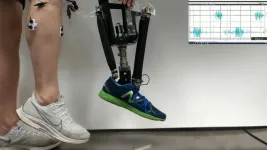(Press-News.org) SAN FRANCISCO — Ronald L. Harter, M.D., FASA, professor of anesthesiology in the Department of Anesthesiology at The Ohio State University Wexner Medical Center in Columbus, was today named president of the American Society of Anesthesiologists (ASA), the nation’s largest organization of physician anesthesiologists. Dr. Harter assumed office at the ANESTHESIOLOGY® 2023 annual meeting and will serve for one year.
“ASA is the premier educational, research and scientific organization representing anesthesiology in the U.S., and I’m honored to have this opportunity to advance our Society’s mission and strengthen our specialty for the benefit of our patients,” said Dr. Harter. “I’m committed to addressing the many challenges in the health care environment, including preserving physician-led anesthesia care for our Veterans, addressing the broken Medicare physician payment program, tackling health care workforce imbalances, and working to create an efficient and balanced process to resolve payment disputes between anesthesiologists and insurers.”
Dr. Harter is a member of ASA’s Executive Committee and Administrative Council. Over the past three decades, he has served ASA in numerous roles, most recently as ASA president-elect. He served as speaker of ASA’s House of Delegates and ASA’s representative to the National Academy of Medicine’s Action Collaborative on Clinician Well-Being and Resilience. He has chaired ASA’s Ad Hoc Committee on Physician Well-Being, Committee on Young Physicians, Committee on Medical Students and Residents, and Committee on Bylaws.
Additionally, Dr. Harter has been an active member of the Ohio Society of Anesthesiologists since 1994 and served as its president in 2003.
“Dr. Harter brings an incredible breadth of experience and expertise to this position,” said ASA Immediate Past President Michael W. Champeau, M.D., FAAP, FASA. “His leadership, perspective and collaborations will continue to help ASA better serve its 56,000 members, advance our specialty and ensure that patient safety remains our highest priority.”
Dr. Harter received a Bachelor of Arts in chemistry from Capital University in Bexley, Ohio, and completed his Doctor of Medicine at The Ohio State University in Columbus. He completed his residency in anesthesiology at Georgetown University Medical Center in Washington, D.C., and is board-certified by the American Board of Anesthesiology.
He resides in Columbus, Ohio, with his wife Katharine; they have five children.
THE AMERICAN SOCIETY OF ANESTHESIOLOGISTS
Founded in 1905, the American Society of Anesthesiologists (ASA) is an educational, research and scientific professional society with more than 56,000 members organized to advance the medical practice of anesthesiology and secure its future. ASA is committed to ensuring anesthesiologists evaluate and supervise the medical care of all patients before, during and after surgery. ASA members also lead the care of critically ill patients in intensive care units, as well as treat pain in both acute and chronic settings.
For more information on the field of anesthesiology, visit the American Society of Anesthesiologists online at asahq.org. To learn more about how anesthesiologists ensure patient safety, visit asahq.org/madeforthismoment. Join the ANESTHESIOLOGY® 2023 social conversation today. Like ASA on Facebook, follow ASALifeline on Twitter and use the hashtag #ANES23.
# # #
END
EMBARGOED FOR RELEASE UNTIL 4 P.M. ET, WEDNESDAY, OCTOBER 18, 2023
MINNEAPOLIS – Having a COVID-19 infection is associated with an increased risk of developing the rare disorder called Guillain-Barré syndrome within the next six weeks, according to a study published in the October 18, 2023, online issue of Neurology®, the medical journal of the American Academy of Neurology. The study also found that people who received the mRNA vaccine from Pfizer-BioNTech were less likely to develop the ...
Research testing new technology to more effectively locate polar bear dens across the Arctic is showing promising results. Researchers from Simon Fraser University and Brigham Young University (BYU), collaborating with Polar Bears International, hope that improving detection tools to locate dens—which are nearly invisible and buried under snow—will help efforts to protect mother polar bears and their cubs.
Results of a pilot study aimed at improving den location in Churchill, Manitoba—using ARTEMIS Inc., an imaging system that relies on Synthetic Aperture Radar, or SAR—are published this week ...
(WASHINGTON) -- “What keeps you up at night?”
It’s a question Anthony Fauci, MD, heard repeatedly over the course of his nearly four decades as director of the National Institute of Allergy and Infectious Diseases at the National Institutes of Health.
Now a Distinguished University Professor at Georgetown University School of Medicine and the McCourt School of Public Policy, Fauci says he realized his worst nightmare -- a twist on the usual question -- in January 2020 when the type of virus he most feared triggered a worldwide pandemic.
Today, as the COVID-19 pandemic wanes, Fauci describes a new nemesis ...
Robotic prosthetic ankles that are controlled by nerve impulses allow amputees to move more “naturally,” improving their stability, according to a new study from North Carolina State University and the University of North Carolina at Chapel Hill.
“This work focused on ‘postural control,’ which is surprisingly complicated,” says Helen Huang, corresponding author of the study and the Jackson Family Distinguished Professor in the Joint Department of Biomedical Engineering at NC State and UNC.
“Basically, when we are standing still, ...
A new study carried out in mice, led by Queen Mary University of London, has identified cells that drive the spread of pancreatic cancer and discovered a weakness in these cells that could be targeted using existing drugs. This offers a promising new approach for treating pancreatic cancer.
The research, published in Science Advances and funded by Barts Charity and Cancer Research UK, found that many patients' pancreatic cancer contains cells called amoeboid cells. These are aggressive, invasive ...
About 40,000 years ago, Neanderthals, who had lived for hundreds of thousands of years in the western part of the Eurasian continent, gave way to Homo sapiens, who had arrived from Africa. This replacement was not sudden, and the two species coexisted for a few millennia, resulting in the integration of Neanderthal DNA into the genome of Sapiens. Researchers at the University of Geneva (UNIGE) have analyzed the distribution of the portion of DNA inherited from Neanderthals in the genomes of humans (Homo sapiens) ...
A large, population-wide study of Denmark residents with type 2 diabetes shows that migrants typically face a greater risk of inferior care for their disease than native Danes, particularly when it comes to monitoring their disease and controlling biomarkers—managing blood levels of key substances that are associated with diabetes. Anders Aasted Isaksen of Aarhus University and Steno Diabetes Center Aarhus, Denmark, and colleagues present these findings in the open-access journal PLOS Global Public Health.
Prior research ...
As climate change warms the planet and droughts are anticipated to become more frequent and extreme, a new study reveals how reduced water flows and rising atmospheric temperatures are set to heat our rivers - creating major challenges for aquatic life, ecosystems, and society.
Water temperature is an important control for all the physical, chemical, and biological processes in rivers. It is particularly important for organisms that cannot regulate their own body temperature, such as fish. River temperature is important for human health and industrial, domestic, and recreational ...
ESMO calls on EU member states to adopt a five-year threshold for cancer survivors’ right to be forgotten when transposing the revised EU Consumer Credits Directive to their national legislation
The Society has been selected as one of the key stakeholders involved in the development of the EU Code of Conduct which seekS to ensure that advances in cancer care are reflected in the commercial practices of financial service providers
The ESMO Patient Advocacy Working Group aims to launch a pan-European campaign to illustrate to decision-makers the life-changing impact of a simple ...
A woman’s fertility normally decreases by her late 30s with reproductive function eventually ceasing at menopause. It is known that a small molecule called nicotinamide adenine dinucleotide (NAD+) plays a critical role in this decline, and Buck scientists have revealed how this happens and have identified potential new approaches to enhance reproductive longevity.
“Studying ovarian biology and reproductive aging is not just about trying to increase fertility, but really about the overall ...

